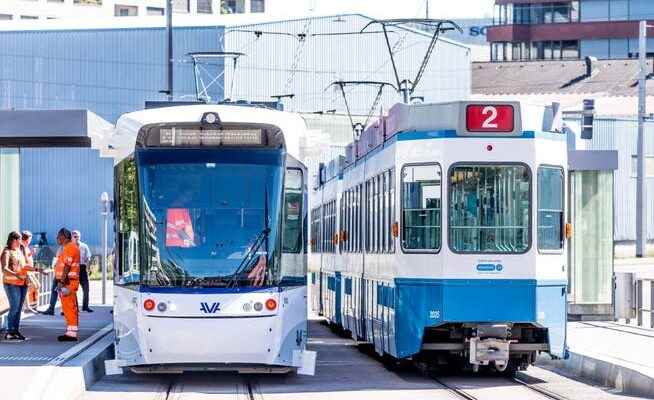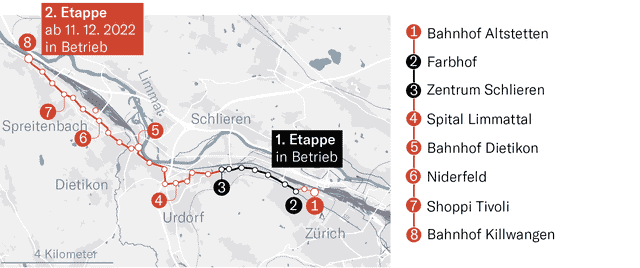After two referendums and five years of construction, the light rail west of Zurich is ready for the start at the weekend – a success story.
Tram meets Stadtbahn: Unlike the 2-seater, there is neither a front nor a back on the vehicles of the Limmattalbahn.
In the beginning there was an Anglicism. In 2007, all municipal executives in the Limmat Valley called for a cross-cantonal light rail system from Zurich Altstetten to Killwangen-Spreitbach with a “letter of intent” – by 2022 at the latest.
The request was broadly recognized in principle. But probably only a few enthusiasts believed that the time limit would be met. Appeals have slowed down many a large project in the Zurich area. In this case, they could do little. The Limmattalbahn is also an example of what the united will of community leaders can do.
One advantage was undoubtedly that there was already an example of a light rail system in the Glatt valley. North of Zurich, the process of pulling together the communities had taken longer, some first harbored the dream of an elevated railway. But at the end of 2010 the first tram drove from Stettbach to the airport.
resistance in the region
Line 12 in the Glatt valley differs fundamentally from line 20 on the Limmattalbahn in one respect. It opens up the area north of Zurich tangentially through the agglomeration – perpendicular to the transport network, which was historically oriented in a star shape towards the city center. The Limmattalbahn, on the other hand, runs parallel to the other traffic routes – motorway, main road, train and a high-speed cycle route that is yet to be built.
But it opens up important public and private infrastructure better than the S-Bahn. This applies in particular to the Limmattal hospital in Schlieren and the cantonal school in Urdorf, as well as to the oldest shopping center in Switzerland in Spreitbach. In Dietikon’s Niderfeld, on the other hand, a new city district is yet to emerge. Next year, however, the science exhibition Phenomena is to take place here first.
The population in the region was less unanimous. In November 2015, Zurich voters approved the loan for the Limmattalbahn with 64.5 percent. However, the Dietikon district of all places rejected it with 54.1 percent no votes. The critics deemed the transport project unnecessary, excessive and feared that the population growth would be excessive.
Construction of the first stage started in August 2017. It corresponds to the extension of tram line 2 from Farbhof on the outskirts of the city to Schlieren. The section became operational in 2019.
In the meantime, the critics had submitted a popular initiative with the aim of abandoning the second stage. She failed in September 2018 with almost 83 percent no. This time, the people of Limmattal also voted for their new track. In the first third of the 20th century, the “Lisbethli” was already operating between Schlieren, Dietikon and Weiningen; this is what the vernacular affectionately called the suburban tram of the time.
The two stages of the Limmattalbahn have a total of 27 stops over a length of 13.4 kilometers and have 92 percent of their own route. On the one hand, the new connection in Zurich between the Farbhof and Altstetten station is now going into operation. There is also the long section between Schlieren and Killwangen station. In Schlieren, the railway passes under the Färberhüsli area in a 250 meter long tunnel.
There was a tug of war around the location of the depot. It was created on Dietiker Boden near the marshalling yard right on the canton border. The awarding of the company was surprising, as it was believed that the municipal transport company had an advantage. However, the Zurich Transport Association awarded the contract to Aargauer Verkehrs AG after a tender.
Credit not exhausted
A novelty for Zurich are the two-way vehicles from Stadler Rail with a driver’s cab on each side. The Limmattalbahn therefore does not need turning loops like the Zurich tram. Two powerful buffer stops mark their end point in front of Altstetten station.
The loan for the Limmattalbahn amounts to CHF 755 million. The canton of Zurich pays about half, the federal government contributes a third, and the rest of 17 percent goes to Aargau. According to the Limmattalbahn AG, the total costs are about 160 million francs below. An extension to Baden is planned later, but that has not yet been decided.
From the outset, the project involved investments of around CHF 130 million in order to maintain the capacity of the road network and to shift car traffic out of the centers of Schlieren and Dietikon.
The new lift will be officially inaugurated on Friday with one of the last appearances by Federal Councilor Simonetta Sommaruga and many prominent people from the canton and the region. One will follow on Saturday opening party at the depot, with free access. On Sunday, the Limmat Valley Railway will start scheduled operations every quarter of an hour.

